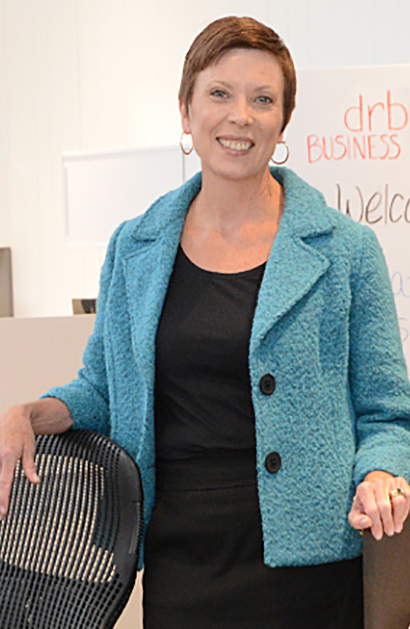
Interiors, supports office health initiatives.
BY RACHEL SPENSIERI
With the new year, many people have resolved
to improve their overall wellness. Similarly, many
businesses are considering ways they can help their
employees stay happy, healthy, and satisfied with
their jobs in 2016.
“During the recession, the workforce was generally
thankful just to have a paycheck,” said Dorothy
Rogers-Bullis, owner of drb Business Interiors, a
workspace design firm located in Saratoga Springs.
“Now that the economy has turned around, employers
can’t take that top talent for granted.”
Indeed, a 2014 LinkedIn study found that over
three-quarters of the global workforce was actively
or passively looking for a new job, so companies
have to up their game to keep the best-of-the-best
on their team.
The way to employees’ hearts may just be, well,
through the heart. Rogers-Bullis increasingly
notices that one approach her clients’ are using
to encourage employee retention is with wellness
programs. But today’s workplace health initiatives
go way beyond putting a gym in the building.
From hiring nutritionists to work with the cafeteria
food service staff to bringing in a yoga teacher for
lunchtime Zen sessions, companies are coming
to understand the sorts of perks that truly make
employees loyal and even improve productivity.
In addition to their updated wellness programs,
Rogers-Bullis said many of her clients’ businesses
are taking an active role in creating work spaces that
are healthier for their employees, as well.
“There are so many benefits to making this investment
including increased productivity and job
satisfaction, and keeping workers active throughout
the day also spurs creativity,” she said.
Some of the trends Rogers-Bullis says she is seeing
in the office design field that can help improve
well being in the workplace include:
• Sit-to-stand desks
“This is a popular option, especially for creative
types,” said Rogers-Bullis. The sit-to-stand desk
can be raised to be used as a standing desk, and
lowered for use as a traditional desk with chair.
“Studies have shown that the differing vantage
points that go along with this change in position
can spark creativity.”
• Dining areas
Too many people have the tendency to work
through lunch, scarfing down some take-out
between responding to emails or returning phone
calls. “To change this habit,” said Rogers-Bullis,
“we see more companies creating attractive dining
areas, often in conjunction with healthier options
in the work cafeteria or vending machines, thus
encouraging people to take a mental break and get
away from their desks for a few minutes.”
• Collaborative breakout spaces
Big conference rooms are becoming a thing
of the past. “The collaborative breakout space fits
the way people engage in business in our modern
times,” Rogers-Bullis said, “and again, they encourage
a change of scenery and get people’s bodies
moving.” These more intimate meeting spaces allow
for collaborative conversations and quick in-person
tête-à -tête that may have otherwise occurred via
email or the phone.
• Stairways to health
To encourage employees to use the stairs instead
of the elevator, Rogers-Bullis said some companies
are designating certain stairwells as “stairways
to health.” Adorned with colorful paint or bright
murals, and featuring upbeat music, as well as Wi-
Fi for wireless devices, these stairs make it fun to
get in a little cardio when going to and from work.
• Ergonomic chairs
“While ergonomic chairs are almost a given in
most work spaces these days,” said Rogers-Bullis,
“many of our clients are seeking out the updated
models that are even more back- and bottom- friendly.”
Newer types of chairs improve circulation
by ensuring knees and hips are not pinched. Better
arm supports help the neck and shoulders remain
properly aligned and pain-free.
• Garbage and recycling stations
Some businesses are taking trash cans out of the
cubicle in favor of garbage and recycling stations,
which require employees to get up and walk to
dispose of trash. “Even those few extra steps can
burn a couple of calories in addition to getting
the blood flowing to the brain, which can increase
productivity and creativity,” noted Rogers-Bullis.
